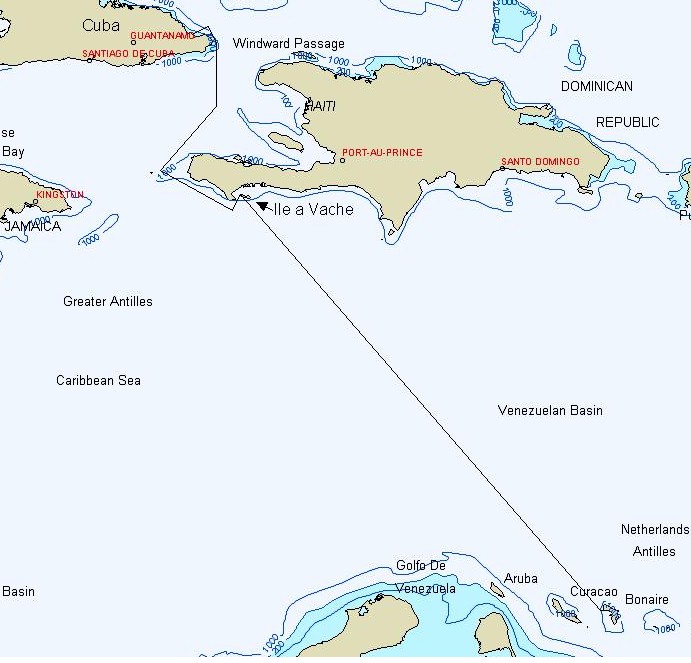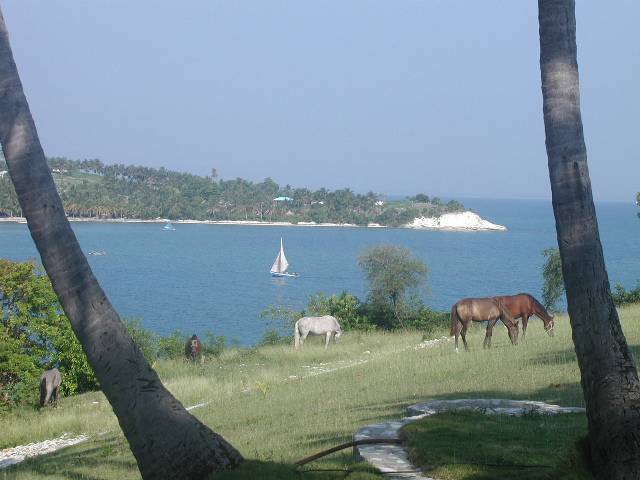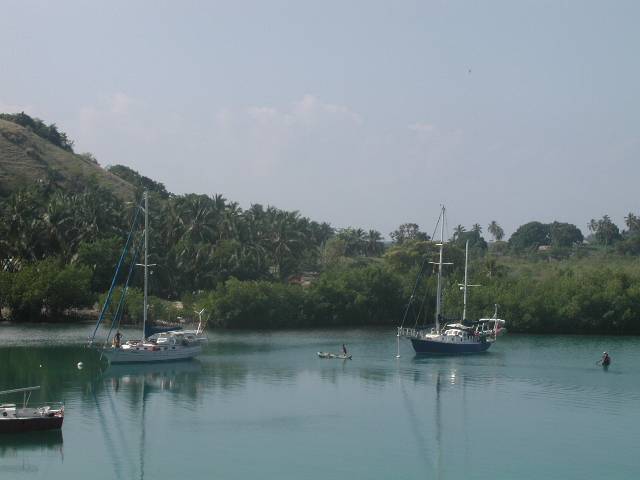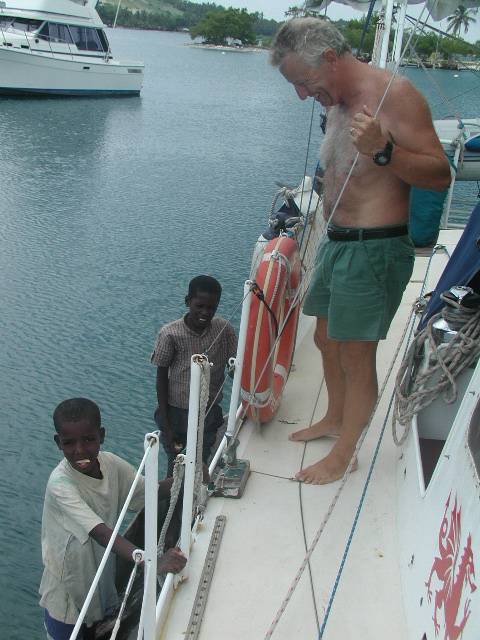Passage from Bonaire to Cuba, via Haiti
3rd - 10th April 2004
We left Bonaire, knowing that two other boats, Pegasus and Pelican, would be following behind in a few hours and would probably soon overtake us, being faster boats. It's nice to know that somebody else is out there too during a long passage and we arranged daily radio schedules, so we would be able to compare notes.
Once we left the lee of the island, we were able to sail well. The swell was a bit uncomfortable, on the quarter, but died down and moved around later. We were invaded by a swarm of small black flies on the foredeck as we tried to put our pole up just south of Bonaire. During the night Pelican and Pegasus were catching us up fast but we were still sailing well and the current was helping us out. It was nice to see their lights during the night.
We were actually enjoying the sailing and have never been so relaxed on a long passage. The current was really helping us out, giving us an average speed of 6 knots. We even enjoyed the night watches with the light from the full moon. Our comfortable new cockpit chair where we could read during watches was a great improvement, why didn't we think of it before? We had also pre-prepared meals, which made life a lot easier at sea.

When the wind dropped off in the afternoon, we raised our cruising chute, which is a lightweight sail, similar to a spinnaker but fixed at the bottom and easier to manage. We hadn't used it before and realised that when it had been hurriedly altered before we left Wales, it must have been cut wrong. The front of the sail didn't fly right, but it did help our speed out, as it was lighter and slightly larger than the genoa, although we expected it to be a lot bigger (another result of the alterations?).
At about 5.30 pm Phil spotted jumping fish right in front of the boat and before he could even walk to the stern to check his lines, he'd caught 2 tuna, which we filleted and froze.
Finally, on the last day before we would reach Haiti, the current turned against us to slow us down and the wind dropped off, so we had to motor but still managed to fly the cruising chute for a while. We arrived at Ile a Vache just before sunset, after completing a slalom through hundreds of fishing buoys. The locals fish from dug out canoes, which are very leaky, or very small sailing boats, neither of which we would fancy being at sea in. Mike from Pelican guided us into the anchorage from his dinghy, as we didn't have a good chart and we were immediately inundated by locals in small boats and dug-out canoes. It would have been quite intimidating if the other boats hadn't already been there. We ended up with about 6 canoes around us, while the occupants hung onto our boat to tout for various kinds of work, mostly boat cleaning and guiding. They were, on the whole, very friendly and curious. Nobody had shoes. We were invited to Pegasus for a barbecue of all the fish we'd collectively caught, which was a real treat after four days at sea.

Local transport, fishing boat and horses.
Later two young men came along showing us the name of a medication one of them needed for a nasty rash on his back and asking if we might have the medicine on board. After consulting the medical books and realising it was a treatment for ringworm, we hurriedly handed over the suitable cream we had aboard and spent the rest of the afternoon scratching psychosomatic itches! We were pleased to be able to help but after a while it became a bit wearing, as we never seemed able to rest for more than a few minutes in preparation for our night passage, before we'd be disturbed by another knock on the hull.

We motored out to the deep water before darkness fell and then, as we'd been warned by the French lady at the hotel about "bad people who may come out from the shore in small boats", we stayed quite a way offshore. We also decided to motor without any navigation lights, to make us harder to spot from the shore, so we had to keep an extra vigilant watch for other ships, although mostly there wasn't anything to see until we got out of the lee of Haiti into the windward passage. We motored until around 3 am, when suddenly a NE wind sprung up and we had a good sail for an hour out to our waypoint off the shoals at the south west of the island.
We were quite nervous around the south of Haiti whenever we saw local boats nearby. By the evening we had current against us but made the best course we could keeping on a north heading until we decided that the winds, which had increased, were probably the stronger NE winds we'd been warned of and decided that we should finally cross over to the Cuba side of the channel.
Things got quite stressful as we were near the traffic separation zone. At one point on Phil's watch we were sandwiched between two large ships going in opposite directions, each only a mile away, which at sea is pretty close to a big vessel!. At 1 am the US Coast Guard hailed us on the VHF, wanting information about us and the boat and our planned course. They didn't board us, but did board Pelican later on. Apparently there is a lot of USCG activity around Haiti right now because of the political troubles.
By dawn we were passing Punta Maisi, the south east tip of Cuba and finally out of the busy shipping lanes.

The talented biscuit and pen snafflers!
We rested for a while and ate a huge lunch (it was nice for a change not to eat out of a mixing bowl as we had during the passage) before heaving up our anchor again and setting off to Puerto Vita. There was no wind at all and we had to start off motoring slowly, to avoid arriving too soon the next morning. We spent a very quiet night motoring along the Cuban coast and watching the ships in the shipping lanes between Cuba and the Bahamas. By 7 am we were almost in Puerto Vita passing the huge resort hotels on the way there.
We made our way gingerly up the river to Puerto Vita but the buoyage was very good and the man from the marina came on the radio to guide us in. The marina is new, so we didn't have it on our charts and were worried as the water was very shallow before the channel was dredged in. We tied up at the dock to quite a welcoming committee and didn't even have time to clean ourselves up before we were inundated with officials; Ernestina (Public Relations from the marina) presenting us with flowers, Umberto the dock master, closely followed by the Doctor, who was first on board to check for the plague ($20)! Close behind came the Port Captain ($10) and Customs man ($20), who filled in numerous forms all with the same information before "searching" the boat. The search consisted of opening up a few cupboards, looking at our videos, our camera, the address book, looking under the sofa at the tools and under the floor in the back cabin at all the junk there. I think they were quite overwhelmed by all our junk! Along came the vet, to check our meat out - he was very entertaining and I had to open up our tinned food storage so he could write down which countries all the meat products came from. He remarked that they don't have sardines in Cuba, so left happily with a 300 bolivar tin of Venezuelan sardines. They were very interested to hear about the places we'd visited, particularly Venezuela, as there is a strong link between the two countries at the moment. The Ministry of Agriculture guy came along next to inspect our vegetables and dry goods (however he didn't see the weevil-ridden flour we cunningly hid from sight, the only flour we'd been able to buy in Bonaire came to life shortly after we left!) Our passports were taken away for our tourist cards to be issued, which we had to pick up at the bar later! The whole process took about 3 hours before we were able to set foot on Cuban land. Then we were happy to enjoy the marinas icy cold showers and it's not often we enjoy cold water! The boat was so hot that everyone got very sweaty and drank our fridge dry of water, juice and coca cola. If they'd waited a while, we could've plugged in the air conditioner we have aboard! That night ours was the only occupied boat in the marina, so for the marina fee of £15 per night (ouch) we had working for us, security guards, a dock master, a barman, a chef, a public relations lady not to mention the doctor, vet, customs man, ministry of agriculture and port captain who were all eagerly awaiting other arrivals. It was quite amazing.